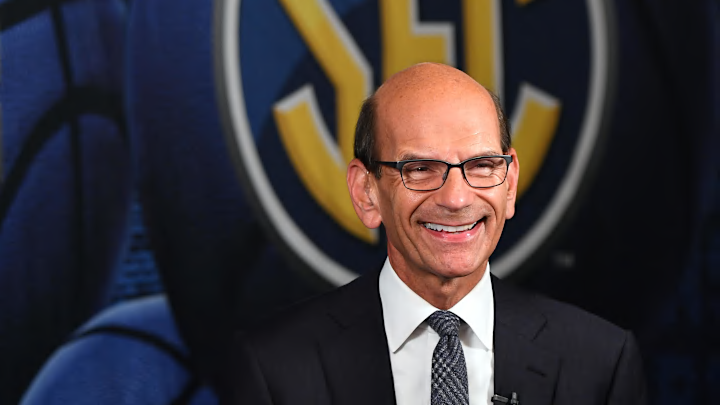Clemson Men’s Basketball reached the Elite 8 of the NCAA Tournament, along with conference foes NC State and Duke. Additionally, North Carolina was also in the Sweet Sixteen before losing to the team that eventually eliminated the Tigers, Alabama.
Four out of five ACC teams in the Big Dance making it out of the first weekend gave support to those who argued the conference was slighted by modern metrics and the selection committee.
Conversely, only two of the eight SEC teams avoiding elimination before the Sweet Sixteen gave fuel to those criticizing the metrics and committee for overvaluing their conference. Five of those six lost to lower-seeded programs.
Alabama’s first Final Four in history should be celebrated by their fans. As a Clemson fan, I am honestly jealous.
The Crimson Tide’s biggest superfan, Paul Finebaum, is taking that achievement a little too far by saying it cancels the ignominy of only 25% of SEC teams advancing to the second weekend.
"When we talked about this last week, I felt like it was a predictable, fake outrage by the media when they were lampooning Commissioner Sankey and others for another busted March. It wasn’t. You have two teams in the Elite Eight. That’s pretty remarkable. "Paul Finebaum
Finebaum continued to defend the SEC by pointing out their success reaching the Final Four over the past ten seasons.
"That’s why this debate about John Calipari a week ago seemed so difficult for him. He hasn’t been to a Final Four since 2015. Since then, within the league? You’ve seen Frank Martin and South Carolina, obviously Bruce Pearl, and, now, Nate Oats. That’s how the game of college basketball is framed once we move on from next weekend. What we have tended to grade programs and conferences on in basketball is how they do in the tournament and, ultimately, do you get to the Final Four and or win a championship."
Before we go further, let’s tally how many programs have made a Final Four and the total appearances each Power conference has achieved in the past ten years (which accounts for nine tournaments).
ACC - Six programs, nine appearances: Duke (2), Miami, NC State, North Carolina (3), Syracuse, Virginia
Big Ten - Four programs, five appearances: Michigan, Michigan State (2), Purdue, Wisconsin
Big 12 – Four programs, five appearances: Baylor, Kansas (2), Oklahoma, Texas Tech
SEC - Four programs, four appearances: Alabama, Auburn, Kentucky, South Carolina
Big East – Two programs, five appearances: UConn (2), Villanova (3)
PAC – Two programs, two appearances: Oregon, UCLA
No mid-major conference has more than one program that has made the Final Four in the past nine tournaments. The West Coast is the only one with two appearances by Gonzaga. Have the Power conferences proven to be better at making Final Fours? Yes, but that wasn't really the original subject matter, particularly as it relates to how Greg Sankey has influenced this situation, but more on that in a minute.
The SEC is tied for second place with four programs making it to the Final Four, but both the other conferences (Big Ten and Big 12) have five total appearances. Additionally, the Big East has only two programs to make the Final Four, but between them, they also have five total appearances.
So even using the metric that Finebaum is using to cancel the original ‘overrated’ criticism, the SEC is average to below average in men’s basketball. When we consider total appearances, the only Power program they have outperformed will not be a functioning conference beyond this academic calendar year.
The SEC’s performance is by no means horrible, but when Greg Sankey is pushing the narrative that the automatic qualifiers from mid-majors are taking away opportunities from Power leagues like his….
"We are giving away highly competitive opportunities for automatic qualifiers [from smaller leagues], and I think that pressure is going to rise as we have more competitive basketball leagues at the top end because of expansion."
….yet his conference saw over 50% of their teams beaten by lower-seeds (two of which were mid-major champions), one team out of eight making it through to the Final Four isn’t that relevant to the big picture discussion.
Sankey was arguing that the depth teams of the Power conferences were more competitive and should be in over the automatic qualifiers for the tournament. Are AQs likely to advance to the Final Four? Not so much, but they are still effective at weeding out pretenders from contenders, like Auburn and Kentucky.
Perhaps the ACC might have a better argument since they have almost twice as many appearances in the past ten years as any other conference, but it would still be apples to oranges. We would still be talking about performance in the first weekend by the depth of the league versus the number of teams that can string enough wins together to make the final weekend.
If anything, it shows that the SEC has been given too much benefit of the doubt that their conference is deeper than others. It certainly appears the label of ‘top-heavy’ should have been applied to them instead of the ACC.
Circling back to Finebaum, his argument favoring Sankey and the SEC sounds good, but the conference ultimately doesn’t back up his case with actual results. He can get away with slapping lipstick on that pig in football because the SEC’s quantified achievements in the BCS and CFP are more impressive.
Finebaum has been successful in distracting from the reality that the football depth of the SEC hasn’t been all that impressive in the past decade, but he should stick to the gridiron. The SEC just doesn’t have the resume to make his argument anything more than lips service for his target audience.
